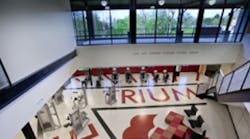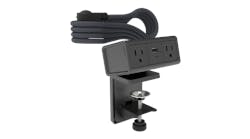Many school and college campuses are like small cities—they offer a little bit of everything. Although academic buildings and residence halls account for a sizable percentage of the facilities on a campus, the academic community on a school campus can include other buildings with specialized design and performance needs: laboratories, weightrooms, computer labs and cafeterias. As education institutions plan these facilities, they should evaluate carefully the design, performance and sustainability features of the building materials and finishes being used.
In an education facility, flooring often serves as the basis of a design plan and a maintenance regimen. Durability, resistance to heavy foot traffic, comfort underfoot and green benefits make rubber flooring a practical choice for the classrooms, auditoriums, corridors and stairwells of many academic buildings.
Because of the variety of performance benefits it provides, rubber flooring also can be an appropriate choice for specialty areas in many buildings.
Strong like rubber
Rubber is strong and resilient. Its durability ensures an extended life cycle for education spaces; rubber floor coverings can last up to 30 years. Some flooring materials can become brittle after an extended period of time, but high-quality rubber has a dense, nonporous surface that can withstand high foot traffic and heavy rolling loads. This represents a tremendous benefit for athletic facilities; multi-purpose rooms experience a constant influx of visitors, and weightrooms require a surface that protects against the residual indentation caused by intermittent dropping of free weights.
Additionally, institutions that operate ice rinks can use specialty rubber flooring in areas immediately surrounding the ice; the rubber is resistant to punctures and slices caused by ice skates. The slip-resistant surface enhances safety and helps prevent injury.
Green and clean
The high-traffic and busy atmosphere of some specialty areas on campuses requires flooring that can be cleaned thoroughly, sustainably and efficiently.
Science laboratories, for example, pose additional technical requirements that rubber flooring meets. The density of rubber flooring enables it to sustain a high-performance atmosphere for a long period of time, eliminating the need for frequent replacement or removal. Rubber flooring does not need to be coated, sealed or waxed, resulting in fewer chemicals. The density of some flooring surfaces also may prevent chemicals that are dropped or spilled from being absorbed into the flooring itself.
Because they never have to be waxed or sealed, rubber floors usually can be maintained with a simple cleaning regimen, often requiring nothing more than a wet mop and a pH-neutral solution.
The absence of wax and sealants streamlines the cleaning process and improves indoor air quality. Cafeterias and dining halls, with their high traffic and the propensity for spills and staining, also benefit from low maintenance requirements.
Education institutions place a premium on information and knowledge. Information is housed in research centers, computer labs and server rooms, and protecting it is important.
Rubber flooring is durable enough to withstand indentations caused by large, heavy electrical equipment often used in these areas. In addition, some rubber flooring includes electrostatic dissipative properties to protect critical electronic devices and equipment. Many of these devices are extremely sensitive to electrostatic discharge. Charges as small as 10 volts may lead to what could be irrevocable damage. The ability to consistently minimize static generation is important for computer and server rooms, where even minor disruptions can cause major damage.
Very, very quiet
Whether the locations are classrooms, lecture halls or more specialized spaces like libraries, laboratories and computer rooms, education institutions need to provide learning spaces where students and staff can concentrate. Proper acoustics sometimes can be the difference between a breakthrough and a failed experiment.
Rubber flooring offers sound-absorption qualities that minimize the noise of shoes that traverse the buildings on an education campus. In some instances, rubber flooring can reduce footfall by up to 20 decibels. Rubber flooring will not eliminate sound, but can help absorb sound and offset some of the distractions common to a busy facility.
So clean you could eat off it
Cafeterias have evolved into popular meeting places that are used for more than just meals. As a gathering place for studying and socializing, cafeterias need to exude a pleasant and friendly ambience to help students and visitors relax and feel welcomed. However, students still eat in cafeterias, and spills are inevitable. Finding a floor covering that is resistant to slips and stains, and offers low maintenance requirements for quick and easy cleanup is essential.
Rubber flooring can provide a simple maintenance regimen that takes care of spills quickly and efficiently with minimal disruption. Rubber flooring also is tough against residual staining, so grape juice, chocolate sauce and other substances with the potential to stain a student’s clothes will not have the same effect on the floor. Rubber floor coverings also are hygienic, as many options are naturally bacteriostatic and fungistatic.
An experiment in versatility
In laboratories, ideas transition to solutions and innovation. Labs come in all shapes and sizes. Some labs require a larger area to accommodate tanks and heavy machinery; the space requirements of others are considerably less. In either case, one thing remains constant
Rubber flooring is stain-resistant, so that even the harshest chemicals, such as betadine, can be cleaned and removed from the floor without leaving any trace or permanent damage. Additionally, the floor covering’s dense, dirt-repellant surface requires no special coating or waxing, so maintenance is simple.
Rubber flooring offers a variety of options—of colors, patterns, textures and perhaps most important, of specialized features and benefits—all labs need high-performance flooring that can withstand a variety of challenges that are especially suited for the versatility of education institutions. Weight rooms where strong floors withstand free weights, laboratory floors that stand up to heavy rolling loads and harsh chemical spills, computer rooms that benefit from electrostatic dissipative qualities, cafeterias that regularly test a floor’s stain resistance, classrooms where sound absorption qualities enhance concentration all benefit from the unique properties that rubber flooring brings to even the most specialized applications.
And every application enjoys the added benefits of a low-maintenance cleaning regimen, long life cycle and contributions to indoor air quality and sustainability, which work together to achieve the design and performance goals of an education building or campus.
Simoneau is a marketing specialist for nora systems, Salem, N.H., a commercial rubber flooring manufacturer. He can be reached at [email protected].
nora systems, .



